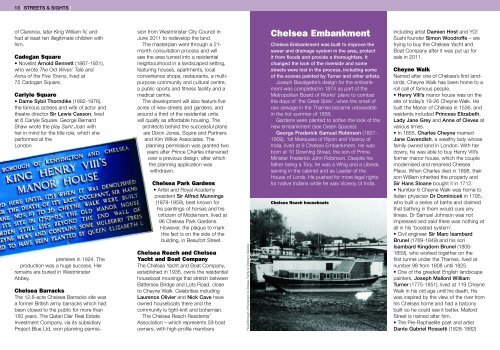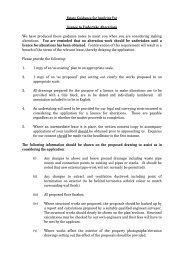The best of Chelsea by the people who know - Cadogan
The best of Chelsea by the people who know - Cadogan
The best of Chelsea by the people who know - Cadogan
You also want an ePaper? Increase the reach of your titles
YUMPU automatically turns print PDFs into web optimized ePapers that Google loves.
13 | STREETS & SIGHTS |<br />
<strong>of</strong> Clarence, later King William IV, and<br />
had at least ten illegitimate children with<br />
him.<br />
<strong>Cadogan</strong> Square<br />
• Novelist Arnold Bennett (1867-1931),<br />
<strong>who</strong> wrote <strong>The</strong> Old Wives' Tale and<br />
Anna <strong>of</strong> <strong>the</strong> Five Towns, lived at<br />
75 <strong>Cadogan</strong> Square.<br />
Carlyle Square<br />
• Dame Sybil Thorndike (1882-1976),<br />
<strong>the</strong> famous actress and wife <strong>of</strong> actor and<br />
<strong>the</strong>atre director Sir Lewis Casson, lived<br />
at 6 Carlyle Square. George Bernard<br />
Shaw wrote <strong>the</strong> play Saint Joan with<br />
her in mind for <strong>the</strong> title role, which she<br />
performed at <strong>the</strong><br />
London<br />
premiere in 1924. <strong>The</strong><br />
production was a huge success. Her<br />
remains are buried in Westminster<br />
Abbey.<br />
<strong>Chelsea</strong> Barracks<br />
<strong>The</strong> 12.8-acre <strong>Chelsea</strong> Barracks site was<br />
a former British army barracks which had<br />
been closed to <strong>the</strong> public for more than<br />
150 years. <strong>The</strong> Qatari Diar Real Estate<br />
Investment Company, via its subsidiary<br />
Project Blue Ltd, won planning permission<br />
from Westminster City Council in<br />
June 2011 to redevelop <strong>the</strong> land.<br />
<strong>The</strong> masterplan went through a 21-<br />
month consultation process and will<br />
see <strong>the</strong> area turned into a residential<br />
neighbourhood in a landscaped setting,<br />
featuring houses, apartments, local<br />
convenience shops, restaurants, a multipurpose<br />
community and cultural centre,<br />
a public sports and fitness facility and a<br />
medical centre.<br />
<strong>The</strong> development will also feature five<br />
acres <strong>of</strong> new streets and gardens, and<br />
around a third <strong>of</strong> <strong>the</strong> residential units<br />
will qualify as affordable housing. <strong>The</strong><br />
architects behind <strong>the</strong> successful plans<br />
are Dixon Jones, Squire and Partners<br />
and Kim Wilkie Associates. <strong>The</strong><br />
planning permission was granted two<br />
years after Prince Charles intervened<br />
over a previous design, after which<br />
<strong>the</strong> planning application was<br />
withdrawn.<br />
<strong>Chelsea</strong> Park Gardens<br />
• Artist and Royal Academy<br />
president Sir Alfred Munnings<br />
(1878-1959), <strong>best</strong> <strong>know</strong>n for<br />
his paintings <strong>of</strong> horses and his<br />
criticism <strong>of</strong> Modernism, lived at<br />
96 <strong>Chelsea</strong> Park Gardens.<br />
However, <strong>the</strong> plaque to mark<br />
this fact is on <strong>the</strong> side <strong>of</strong> <strong>the</strong><br />
building, in Beaufort Street.<br />
<strong>Chelsea</strong> Reach and <strong>Chelsea</strong><br />
Yacht and Boat Company<br />
<strong>The</strong> <strong>Chelsea</strong> Yacht and Boat Company,<br />
established in 1935, owns <strong>the</strong> residential<br />
houseboat moorings that stretch between<br />
Battersea Bridge and Lots Road, close<br />
to Cheyne Walk. Celebrities including<br />
Laurence Olivier and Nick Cave have<br />
owned houseboats <strong>the</strong>re and <strong>the</strong><br />
community is tight-knit and bohemian.<br />
<strong>The</strong> <strong>Chelsea</strong> Reach Residents’<br />
Association – which represents 59 boat<br />
owners, with high-pr<strong>of</strong>ile members<br />
Royal Borough <strong>of</strong> Kensingon & <strong>Chelsea</strong>, Family & Children’s Service<br />
<strong>Chelsea</strong> Embankment<br />
<strong>Chelsea</strong> Embankment was built to improve <strong>the</strong><br />
sewer and drainage system in <strong>the</strong> area, protect<br />
it from floods and provide a thoroughfare. It<br />
changed <strong>the</strong> look <strong>of</strong> <strong>the</strong> riverside and some<br />
streets were lost in <strong>the</strong> process, including some<br />
<strong>of</strong> <strong>the</strong> scenes painted <strong>by</strong> Turner and o<strong>the</strong>r artists.<br />
Joseph Bazalgette’s design for <strong>the</strong> embankment<br />
was completed in 1874 as part <strong>of</strong> <strong>the</strong><br />
Metropolitan Board <strong>of</strong> Works’ plans to combat<br />
<strong>the</strong> days <strong>of</strong> ‘<strong>the</strong> Great Stink’, when <strong>the</strong> smell <strong>of</strong><br />
raw sewage in <strong>the</strong> Thames became unbearable<br />
in <strong>the</strong> hot summer <strong>of</strong> 1858.<br />
Gardens were planted to s<strong>of</strong>ten <strong>the</strong> look <strong>of</strong> <strong>the</strong><br />
new embankment (see Green Spaces).<br />
George Frederick Samuel Robinson (1827-<br />
1909), 1st Marquess <strong>of</strong> Ripon and Viceroy <strong>of</strong><br />
India, lived at 9 <strong>Chelsea</strong> Embankment. He was<br />
born at 10 Downing Street, <strong>the</strong> son <strong>of</strong> Prime<br />
Minister Frederick John Robinson. Despite his<br />
fa<strong>the</strong>r being a Tory, he was a Whig and a Liberal,<br />
serving in <strong>the</strong> cabinet and as Leader <strong>of</strong> <strong>the</strong><br />
House <strong>of</strong> Lords. He pushed for more legal rights<br />
for native Indians while he was Viceroy <strong>of</strong> India.<br />
<strong>Chelsea</strong> Reach houseboats<br />
including artist Damien Hirst and YO!<br />
Sushi founder Simon Woodr<strong>of</strong>fe – are<br />
trying to buy <strong>the</strong> <strong>Chelsea</strong> Yacht and<br />
Boat Company after it was put up for<br />
sale in 2011.<br />
Cheyne Walk<br />
Named after one <strong>of</strong> <strong>Chelsea</strong>’s first landlords,<br />
Cheyne Walk has been home to a<br />
roll call <strong>of</strong> famous <strong>people</strong>.<br />
• Henry VIII’s manor house was on <strong>the</strong><br />
site <strong>of</strong> today’s 19-26 Cheyne Walk. He<br />
built <strong>the</strong> Manor <strong>of</strong> <strong>Chelsea</strong> in 1536, and<br />
residents included Princess Elizabeth,<br />
Lady Jane Grey and Anne <strong>of</strong> Cleves at<br />
various times.<br />
• In 1655, Charles Cheyne married<br />
Jane Cavendish, a wealthy lady <strong>who</strong>se<br />
family owned land in London. With her<br />
dowry, he was able to buy Henry VIII’s<br />
former manor house, which <strong>the</strong> couple<br />
modernised and renamed <strong>Chelsea</strong><br />
Place. When Charles died in 1698, <strong>the</strong>ir<br />
son William inherited <strong>the</strong> property and<br />
Sir Hans Sloane bought it in 1712.<br />
• Number 6 Cheyne Walk was home to<br />
Italian physician Dr Dominiceti in 1795,<br />
<strong>who</strong> built a series <strong>of</strong> baths and claimed<br />
that bathing in <strong>the</strong>m would cure any<br />
illness. Dr Samuel Johnson was not<br />
impressed and said <strong>the</strong>re was nothing at<br />
all in his ‘boasted system’.<br />
• Civil engineer Sir Marc Isambard<br />
Brunel (1769-1849) and his son<br />
Isambard Kingdom Brunel (1806-<br />
1859), <strong>who</strong> worked toge<strong>the</strong>r on <strong>the</strong><br />
first tunnel under <strong>the</strong> Thames, lived at<br />
number 98 from 1808 until 1825.<br />
• One <strong>of</strong> <strong>the</strong> greatest English landscape<br />
painters, Joseph Mallord William<br />
Turner (1775-1851), lived at 119 Cheyne<br />
Walk in his old age until his death. He<br />
was inspired <strong>by</strong> <strong>the</strong> view <strong>of</strong> <strong>the</strong> river from<br />
his <strong>Chelsea</strong> home and had a balcony<br />
built so he could see it better. Mallord<br />
Street is named after him.<br />
• <strong>The</strong> Pre-Raphaelite poet and artist<br />
Dante Gabriel Rossetti (1828-1882)







